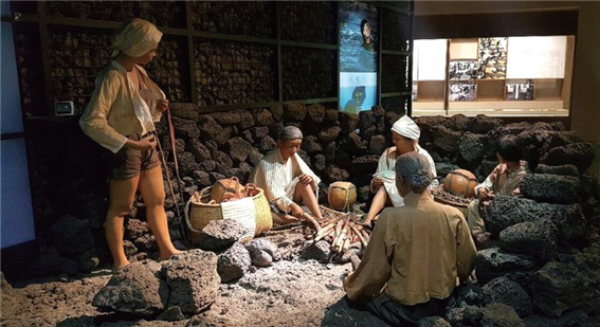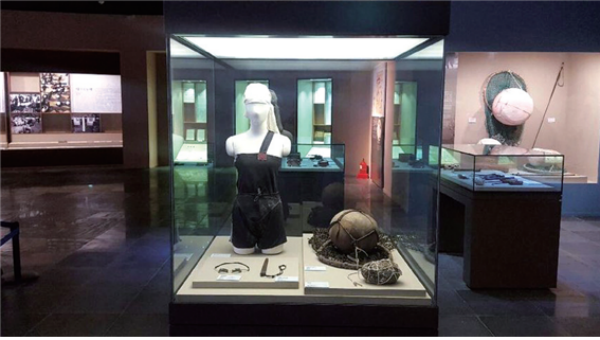Through the eleventh session of the Intergovernmental Committee for the Safeguarding of the Intangible Cultural Heritage held in Adis Ababa, Ethiopia, haenyeo of Jeju has been registered as the 19th intangible cultural heritage of Korea. However, even to Korean people, the concept of haenyeo may come across as unfamiliar. Therefore, the Sungkyun Times (SKT) introduces haenyeo, difficulties in the process of registrating as an intangible cultural heritage, haenyeo’s unique culture passed on to the present, and ways to protect and promote this cultural heritage.
Haenyeo
Haenyeo are female divers who harvest seaweed and shellfish. They usually dive into water as deep as five to ten meters for about two minutes and perform mul-jil (diving to harvest sea products). The haenyeo culture is only found in Korea, especially in Jeju, and in Japan.
The International Council on Monuments and Sites (ICOMOS), which is an affiliate organization of the United Nations Educational, Scientific and Cultural Organization (UNESCO), states that haenyeo contributed to the cultural diversity of the local community and upgraded the rights of women.
- Reasons for Recommendation
•. Strict Rules for Community and Ecosystem
Haenyeo have strict rules in order to prevent danger. They have rules regarding the boundaries of badang farms, process of harvesting seafood, and when to take a hiatus. All these rules and discussions are conducted at bulteok before diving. Bulteok is a place where haenyeo change, prepare to dive, and rest when they return. It is protected by a round stone wall, and has a fireplace at the center to keep haenyeo’s body temperature up. While discussing, haenyeo talk about how far down they should be going as well as the conditions of sea waves. Additionally, haenyeo perform mul-jil with barely any artificial equipment so that they do not harm the environment.

•. Community Spirit
Haenyeo divide their workplace, called badang farms, into several districts so that every haenyeo can work together. Badang is a Jeju dialect meaning “sea,” and people in Jeju also regard the sea as a “farm,” since it offers them food, from which they coined the word badang farm. There are four districts of badang farms: school badang, village foreman’s badang, baby badang, and granny’s badang. The school badang is a place for educating haenyeo over the age of 15 who just started mul-jil. Fish yield from this district is used to manage and run the school badang. The village foreman’s badang is a token of gratitude for the village foreman who always works for the village, and the profits made within this badang farm go to the village foreman. The baby badang refers to the shallowest sea where little girls learn how to dive. Girls in Jeju who want to become haenyeo start learning how to dive from the age of eight and become baby haenyeo. The granny’s badang is not as deep as ordinary badang because it may be dangerous to the old haenyeo to go down far too deep into the sea. All these districts are managed by fishing village communities and the harvested seafood is evenly distributed.
•. Upgrading Women’s Right
Haenyeo are mostly women, and the intensity of their labor is so severe that they often refer to mul-jil as “earning money beyond the grave to feed the children in the living world.” The scope of their work place was not confined to Korea but included Japan, China, and Russia. Their dedication to their children as well as strong economic activity to financially support their family assisted the women’s rights to rise in Korean society.
•. Ceremonies Praying for Safety and Abundance
The Jeju Chilmeoridang Yeongdeung-gut is conducted by the haenyeo along with farmers who wish for an abundant harvest. According to the local lore, a giantess called Yeongdeung Halmang plants seeds of grains and fosters marine life in February. The ceremony was also registered as a UNESCO Intangible Cultural Heritage in 2009.
Difficulties in the Registration Process
•. Korean “Haenyeo” VS. Japanese “Ama”
Among many difficulties in the process of registration, the controversy on Korean “haenyeo” and Japanese “ama” was the toughest. Since this sort of culture only appears in Korea and Japan, it was difficult to decide which country, or rather which group of female divers, would be entitled to being proposed as a UNESCO World Heritage.
Firstly, haenyeo have a long history starting from the Neolithic Age. According to The Chronicles of the Three States, and The Goryeosa, which are the prominent historic documents of Korea, haenyeo paid pearls as a tribute to their kings. The Japanese ama divers, on the other hand, are said to have started during the fifth century as Nihon Shoki, a historical document of Japan, suggests.
Secondly, the diving methods are completely different. Haenyeo dive alone with their bodies connected to a te-wak, a buoyant object made of gourd or polystyrene which helps haenyeo float in water, and harvest seafood with no one else’s help. On the other hand, ama usually work as a pair with their husbands or wives. When one of them dives, the other pulls the rope connected to the diver to keep the diver safe.

French newspaper Le Monde gave media attention to ama in 2013, which came as a shock to the Korean government as UNESCO headquarters are established in Paris. Moreover, many Japanese experts who once admitted that haenyeo were the ancestors of ama started to withdraw their stances and claim that the history of ama had begun three thousand years earlier. In 2014, Mie Prefecture, a region in Japan, registered ama as their intangible folk cultural property. Japan also released a drama series about ama and held festivals and forums when the G7 summit was held in Mie Prefecture.

This confrontation between haenyeo and ama continued, but since ama were not registered as a state-designated cultural property, ama could not apply for the UNESCO World Heritage List.
Jeju Haenyeo in Present
Although UNESCO recognized the value of haenyeo, they are having a hard time due to several reasons.
- Aging of Haenyeo
Among 4,377 haenyeo, 85.7% of them are over 60. More specifically, 32.2% are in their sixties, 43.4% are in their seventies, and 11.1% are over 80. These figures are alarming because they show that if there are no more young successors, haenyeo are in danger of disappearing in the next 20 years. As more and more haenyeo are growing old, the Jeju District Office is planning to
make 15 more granny’s badang until 2017 to protect them.
•. Continuing Safety Accidents
As of this year alone, seven haenyeo died while working. The number of casualties has continued to increase for the past ten years. Originally, haenyeo used to not go down further than ten meters deep into the water. As the number of marine life decreased, however, they have started to go down further, which made them more prone to accidents. The government is advising haenyeo to shorten their working hours, and providing them with orange wetsuits and te-waks.
•. Exclusive Haenyeo Society
Since haenyeo only reside in Jeju and their culture is passed on to their daughters and neighbors, they do not enjoy new people coming into their society. Haenyeo are worried that they might not be able to protect and preserve their distinctive features if they are easily distracted by strangers.
Effort to Preserve Haenyeo,
The Jeju District Office established the Jeju Haenyeo Museum to introduce haenyeo culture to visitors. The SKT interviewed Curator Lee Ji-eun at the Jeju Haenyeo Museum.
What are the main objectives of the Jeju Haenyeo Museum? What things do you exhibit in the museum?

The Jeju Haenyeo Museum scrutinizes, researches, manages, and exhibits the haenyeo culture to systematically preserve it. Promoting the haenyeo culture to register it as a UNESCO intangible cultural heritage was one of our projects.
What are the unique diving techniques that only haenyeo have?
Haenyeo dive into water without any electric devices. They control their breath by themselves. Haenyeo dive vertically, and hold their breath and exhale at once as they emerge. As they exhale very fast, it sounds like whistling: “ho-o-i-ho-o-i.” It is called “Sum-bi-so-ri.”
How significant are haenyeo in Korea?
The haenyeo culture is drawing attention as a sustainable development model not only in Korea, but all over the world. Actually, the haenyeo culture was selected as an agenda for the conference from the International Union for Conservation of Nature. The depletion of resources, environmental pollution, and conflicts caused by unequal distribution are problems all over the world. Haenyeo take care of the sea by doing “rocky cleaning” and made their own rules to coexist with the ecosystem such as prohibiting seafood during breeding season. Moreover, haenyeo maintain the community with a strict order of rank, but make decisions through free debates. Haenyeo also made the granny’s badang for old haenyeo and contributed to the public with the school badang and village foreman’s badang. They could serve as a model for modern society to solve the problems mentioned above.
What efforts have you made to promote the haenyeo culture?
We upload video clips introducing haenyeo on Youtube, Facebook, and Kakao Story. Moreover, the Jeju Haenyeo Museum promotes educational programs about the haenyeo culture and their exclusive diving methods, and advertisements for each fishing village fraternity. In addition, there are also haenyeo schools including the Hansupul Haenyeo School and Beophwan Jomnyeo Village Women Divers School. They provide an opportunity to work as an intern.
Are there any plans for promoting the haenyeo culture after the registration as a UNESCO intangible cultural heritage?
In mid-December, we are going to hold an event to celebrate the registration.
The Jeju Provincial Office also established a project to promote the haenyeo culture and to designate a national day that celebrates it. The office is also thinking of including the haenyeo culture in textbooks. Additionally, the Jeju Provincial Office will also try to register haenyeo’s unique fish industry in the Globally Important Agricultural Heritage System (GIAHS), to give financial support to haenyeo.
Any last words for Kingos?
As the culture of Jeju Haenyeo is registered as a UNESCO intangible cultural heritage, it garnered huge attention from the world. The registration, however, is not enough to preserve and pass the culture down to the next generation. We should keep the momentum going and an affectionate attention to haenyeo.
